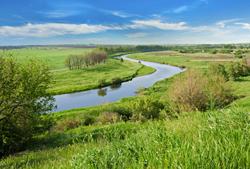Ecosystem Services

Ecosystem goods and services produce the many life-sustaining benefits we receive from nature—clean air and water, fertile soil for crop production, pollination, and flood control. These ecosystem services are important to environmental and human health and well-being, yet they are limited and often taken for granted.
Ecosystem-focused research develops methods that measure ecosystem goods and services. This research addresses:
- how to estimate current production of ecosystem goods and services, given the type and condition of ecosystems;
- how ecosystem services contribute to human health and well-being; and
- how the production and benefits of these ecosystem services may be reduced or sustained under various decision scenarios and in response to regional conditions.
Researchers are exploring and interpreting primary health data and social surveys, and are developing indicators for benefits associated with access to natural areas, such as improved health, reduced costs of healthcare, and improved social ties. Understanding research outcomes will lead to improved environmental management and planning that can inform urban design, strengthen neighborhoods, and contribute to community vitality, economic health and livability.
Related Resources
- Ecological Risk Assessment Support Center (ERASC)
A support center that provides technical information and addresses scientific questions of concern or interest on topics relevant to ecological risk assessment at hazardous waste sites for EPA's Office of Solid Waste and Emergency Response (OSWER) personnel and the Office of Resource Conservation and Recovery (ORCR) staff. - Ecosystems and Climate Change Research
- Oil Spills Research
Ecosystem Decision Support Tools
- Causal Analysis/Diagnosis Decision Information System (CADDIS)
A website developed to help scientists and engineers in the Regions, States, and Tribes conduct causal assessments in aquatic systems. - Eco-Health Relationship Browser
An interactive tool provides information about several of our nation's major ecosystems, the services they provide, and how those services, or their degradation and loss, may affect people - Ecoregion Maps and GIS Resources
Designed to serve as a spatial framework for the research assessment, and monitoring of ecosystems and ecosystem components, ecoregions denote areas within which ecosystems (and the type, quality, and quantity of environmental resources) are generally similar. - EnviroAtlas
A collection of interactive tools and resources that allows users to explore the many benefits people receive from nature, often referred to as ecosystem services. - EcoService Models Library (ESML)
The ESML is an online database for finding, examining and comparing ecological models that may be useful for quantifying ecosystem goods and services. - EPA H20 Tool
EPA H2O is a desktop GIS-based decision support tool for assessing the provision of ecosystem services under different land use scenarios. - National Ecosystem Services Classification System (NESCS)-Plus
The National Ecosystems Classification System-Plus (NESCS Plus, pronounced “nex-us plus”) is one such tool is a robust, step-by-step resource for tracing the links between natural ecosystems and human well-being. The main purpose of NESCS Plus is to serve as a framework for analyzing how changes to ecosystems impact human welfare.
- National Ecosystem Services Classification System (NESCS): Framework Design and Policy Application
NESCS provides a framework that will aid in analyzing the human welfare impacts of policy-induced changes to ecosystems. - Rapid Benefit Indicators (RBI) Approach
The Rapid Benefit Indicator (RBI) approach is an easy-to-use process for assessing restoration sites using non-monetary benefit indicators. It uses readily-available data to estimate and quantify benefits to people around an ecological restoration site. -
Visualizing Ecosystem Land Management Assessments (VELMA) Model - 2.0
VELMA can be used to help improve the water quality of streams, rivers, and estuaries by making better use of both natural and engineered green infrastructure (GI) to control loadings from nonpoint sources of pollution.
Ecosystem-Specific Resources
- Lowering Barriers to Achieving Multiple Environmental Goals in the Chesapeake Bay
An order that requires federal agencies to work together to bring new resources and tools to the Bay restoration effort, including new approaches to implementing the Clean Water Act (CWA) and new funding for voluntary efforts by farmers. - An Optimization Approach to Evaluate the Role of Ecosystem Services in Chesapeake Bay Restoration Strategies
The report assesses pollution control projects and their affects on water quality and ecosystem services. - Yaquina Bay: Bird Use of Estuarine Habitats
An assessment of bird utilization patterns of the intertidal soft sediment and low marsh habitats of the Yaquina estuary, Oregon
